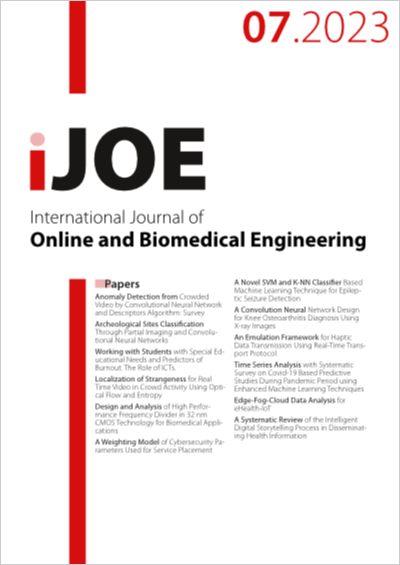A Convolution Neural Network Design for Knee Osteoarthritis Diagnosis Using X-ray Images
DOI:
https://doi.org/10.3991/ijoe.v19i07.40161Keywords:
Osteoarthritis Diagnosis, Deep learning, Classification, Convolution Neural Network, X-ray ImagesAbstract
Knee osteoarthritis (OA) is a chronic degenerative joint disease affecting millions worldwide, particularly those over 60. It is a significant cause of disability and can impact an individual's quality of life. The condition occurs when the cartilage in the knee joint wears away over time, leading to bone-on-bone contact, which can result in pain, stiffness, swelling, and decreased range of motion. Deep neural networks, especially convolutional neural networks (CNN), are powerful tools in medical applications such as diagnosis and detection. This research proposes a CNN model to classify knee osteoarthritis into five categories using x-ray images. These classes are labeled: Minimal, Healthy, Moderate, Doubtful, and Severe. Furthermore, the proposed CNN model has been compared with two pre-trained transfer learning models: Xception and InceptionResNet V2. These models were evaluated based on precision, recall, F1 score, and accuracy. The results showed that although all three models performed very well, the proposed model outperformed both transfer learning models with 98% accuracy. It also achieved the highest values for other parameters such as precision, recall, and F1 score. The proposed model has several potential applications in clinical practice, such as assisting doctors in accurately classifying knee osteoarthritis severity levels by analyzing single X-ray images.
Downloads
Published
How to Cite
Issue
Section
License
Copyright (c) 2023 Asadullah Shaikh, Saleh Hamad Sajaan Almansour, Rahul Singh, Saleh Mabruk Hadrami Alyami, Neha Sharma, Mana Saleh Al Reshan, Sheifali Gupta

This work is licensed under a Creative Commons Attribution 4.0 International License.



